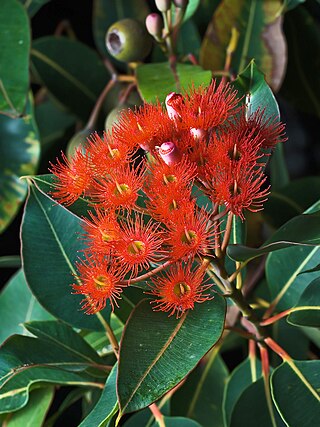
Corymbia ficifolia (syn. Eucalyptus ficifolia, commonly known as the red flowering gum, is a species of small tree that is endemic to the south-west of Western Australia. It has rough, fibrous bark on the trunk and branches, egg-shaped to broadly lance-shape adult leaves, flower buds in groups of seven, bright red, pink or orange flowers and urn-shaped fruit. It has a restricted distribution in the wild but is one of the most commonly planted ornamental eucalypts.

Eucalyptus accedens, commonly known as smooth bark wandoo or powderbark wandoo is a species of tree endemic to the south-west of Western Australia. Although the common names suggest it is similar to wandoo,, the two species are very different botanically. The bark of E. accedens has talc-like powder, at least on the protected side of the trunk and the tree usually grows on laterite in higher places.

Eucalyptus cladocalyx, commonly known as sugar gum, is a species of eucalypt tree found in the Australian state of South Australia. It is found naturally in three distinct populations - in the Flinders Ranges, Eyre Peninsula and on Kangaroo Island.

Eucalyptus melanophloia, commonly known as silver-leaved ironbark, is a species of tree that is endemic to northeastern Australia. It is a small to medium-sized tree with rough, hard ironbark on the trunk and branches. The crown is usually composed of juvenile leaves that are dull, glaucous, sessile and arranged in opposite pairs. The flower buds are arranged in groups of seven, the flowers white and the fruit cup-shaped to hemispherical.

Eucalyptus miniata, commonly known as the Darwin woollybutt or woolewoorrng, is a species of medium-sized to tall tree that is endemic to northern Australia. It has rough, fibrous, brownish bark on the trunk, smooth greyish bark above. Adult leaves are lance-shaped, the flower buds are ribbed and arranged in groups of seven, the flowers orange or scarlet and the fruit is cylindrical to barrel-shaped or urn-shaped, with ribs along the sides.

Corymbia polycarpa, also known as the long-fruited bloodwood or small-flowered bloodwood, is a species of tree that is endemic to northern Australia. Indigenous Australians of different language groups have different names for the tree. The Nungali peoples know the tree as narrga or gunjid, the Mulluk-Mulluk know it as dawart, the Yangman know it as bodog, the Gurindji peoples as jadburru and the Wagiman as jagatjjin. It is a medium-sized tree with rough, tessellated bark on the trunk and branches, lance-shaped to curved adult leaves, flower buds in groups of seven or nine, white or cream-coloured flowers and barrel-shaped fruit.

Eucalyptus bigalerita, commonly known as the northern salmon gum, Adelaide River white gum, or poplar gum is a species of tree that is endemic to north-western Australia. It has smooth bark, large triangular to more or less round adult leaves, flower buds in groups of seven, white flowers and conical to hemispherical fruit.
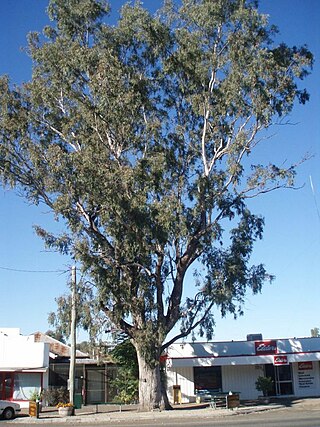
Eucalyptus microtheca, commonly known as the coolibah, is a species of tree that is endemic to northern Australia. It has rough, flaky or fibrous bark on the trunk and branches, lance-shaped adult leaves, flower buds in groups of seven, white flowers and spherical to conical fruit. It is widely distributed from the Kimberley region of Western Australia to Cape York in Queensland.
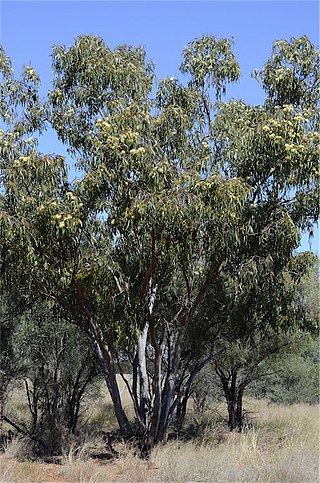
Eucalyptus ochrophloia, commonly known as the yapunyah, is a species of eucalypt native to inland New South Wales and Queensland in eastern Australia.
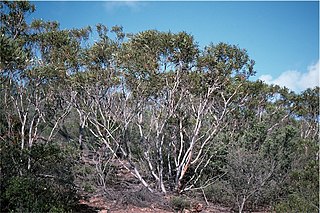
Eucalyptus lehmannii, commonly known as bushy yate, is a eucalypt in the myrtle family Myrtaceae endemic to the south-west of Western Australia. It is a small tree with an oval, spreading form and dense foliage which sometimes reaches to the ground. It is widely cultivated in Australia and the United States because of its ornamental shape and decorative flowers, buds and fruit. There has been some confusion about its classification because of its ability to hybridise.

Eucalyptus exserta, commonly known as Queensland peppermint, peppermint, bendo, yellow messmate or messmate, is a species of tree or a mallee and is endemic to eastern Australia. It has hard, fibrous bark, lance-shaped adult leaves, flower buds in groups of seven, white flowers and hemispherical or cup-shaped fruit.

Eucalyptus leucophloia, commonly known as snappy gum or migum, is a species of small tree or mallee that is endemic to northern Australia. The indigenous Mangarayi and Yangman peoples know the tree as mirndir, the Ngarluma name it as malygan and Yindjibarndi peoples know the tree as majgan. It has smooth, powdery bark, lance-shaped to egg-shaped adult leaves, flower buds usually in groups of seven, white flowers and cup-shaped, barrel-shaped or hemispherical fruit.

Eucalyptus odontocarpa, commonly known as Sturt Creek mallee, is a mallee that is native to northern Australia. Indigenous Australians know the plant as Warilyu.
Eucalyptus ovularis, commonly known as small-fruited mallee, is a species of mallee or a tree that is native to Western Australia.

Eucalyptus sessilis, commonly known as Finke River mallee, red bud mallee or river mallee, is a species of mallee that is native to the Northern Territory and central areas along the border of Western Australia. It has smooth bark, sometimes with ribbon of old bark near the base, lance-shaped to egg-shaped or elliptical adult leaves, flower buds in groups of seven, creamy yellow flowers and hemispherical fruit.

Eucalyptus tetrodonta, commonly known as Darwin stringybark or messmate, is a species of medium-sized to tall tree that is endemic to northern Australia. It has rough, stringy or fibrous bark on the trunk and branches, lance-shaped leaves arranged in opposite pairs, flowers buds in groups of three, whitish to cream-coloured flowers and cylindrical fruit.

Corymbia confertiflora, commonly known as the broad-leaved carbeen or the rough leaf cabbage gum, is a species of tree that is endemic to northern Australia. It has rough, tessellated bark near the base of the trunk, smooth white to pale grey bark above, a crown of both intermediate and adult leaves, large numbers of flower buds borne on leafless sections of branchlets in groups of seven, creamy white flowers and cylindrical to barrel-shaped or bell-shaped fruit.

Eucalyptus leptophleba, commonly known as Molloy red box or Molloy box, is a species of tree that is endemic to Queensland. It has rough, fissured bark on the trunk and branches, lance-shaped or curved adult leaves, flowers buds on a branching peduncle on the ends of branchlets, white flowers and cup-shaped to barrel-shaped fruit.
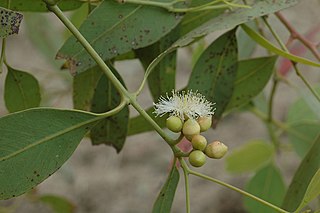
Eucalyptus patellaris, commonly known as weeping box, is a species of tree that is endemic to the Northern Territory in Australia. It has rough, fibrous to flaky bark on the trunk and branches, lance-shaped or curved adult leaves, flower buds in groups of seven, white flowers and bell-shaped or cup-shaped fruit.
Eucalyptus moderata, also known as redwood mallee, is a species of tree or a mallee that is endemic to the southwest of Western Australia. It has rough, hard, fibrous bark on some or all of the trunk, lance-shaped adult leaves, flower buds usually in groups of seven, pale yellow flowers and pendulous, urn-shaped fruit.



















